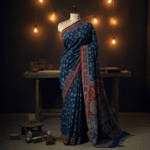India’s love affair with the saree runs deep. It’s more than a garment — it’s culture, tradition, and personal expression all wrapped in six (or nine) yards of fabric. What makes the saree even more fascinating is how it transforms from state to state. The way it’s draped can tell you where a woman comes from, what occasion she’s celebrating, or even what community she belongs to.
This guide breaks down the most iconic saree draping styles across India, giving you a practical, no-nonsense overview of how each region brings its own flavor to this timeless attire.
1. Nivi Style – Andhra Pradesh & Telangana
The Classic Look You Already Know
If you’ve ever worn a saree, chances are it was in the Nivi style. Originating from Andhra Pradesh, this is the most popular drape across modern India.
- How It’s Worn: The saree is pleated in the front, tucked into the waistband, and the pallu is draped over the left shoulder.
- Best For: Office wear, casual events, weddings with a contemporary twist.
- Pro Tip: Perfect for those starting out. Accessorize with belts or jackets for a fusion look.
2. Bengali Style – West Bengal
Elegant Simplicity with a Big Pallu Statement
The Bengali drape is known for its wide, box pleats and heavily adorned pallus.
- How It’s Worn: No pleats in front. The pallu is wrapped around and comes over both shoulders.
- Special Touch: Often paired with a set of keys at the waist and large bindis.
- Occasion: Ideal for Durga Puja or traditional ceremonies.
3. Maharashtrian Nauvari – Maharashtra
Warrior-Like Grace with a Masculine Edge
The Nauvari (meaning nine yards) style lets you move freely — almost like wearing trousers.
- How It’s Worn: The saree is tucked at the back, passed between the legs, and draped like dhoti pants, with the pallu elegantly thrown over the shoulder.
- Perfect For: Folk dances, traditional weddings, and festive processions.
- Why It’s Loved: A nod to the Maratha warriors, it’s bold, functional, and powerful.
4. Madisar – Tamil Nadu
Sacred Simplicity with Religious Significance
This traditional drape is worn mainly by Tamil Brahmin women during religious ceremonies.
- How It’s Worn: Like the Nauvari, it uses a nine-yard saree, but involves intricate pleating and front-to-back wrapping.
- Special Context: Mandatory for certain life events like weddings or rituals.
- Style Note: Typically worn without elaborate embellishments, focusing on purity and tradition.
5. Gujarati Style – Gujarat
Front-Facing Pallu for Maximum Glamour
If you’ve seen Bollywood weddings, you’ve seen this style.
- How It’s Worn: Similar to Nivi, but the pallu comes over the right shoulder and is spread across the front.
- Why It Shines: The decorated pallu becomes the centerpiece.
- Great For: Garba nights, weddings, Navratri celebrations.
6. Coorgi Style – Karnataka
Functional Elegance from the Hills of Coorg
Distinct and practical, this style is worn by the Kodava community in Coorg.
- How It’s Worn: The pallu comes from the back over the right shoulder and is pinned at the waist.
- Signature Element: Often paired with a matching blouse and a decorative waistbelt.
- Perfect For: Community functions, traditional dances, and weddings.
7. Assamese Mekhela Chador – Assam
Not a Saree, but Close Enough
Though technically not a saree, the Mekhela Chador is Assam’s version of graceful draping.
- How It’s Worn: Two-piece attire — the ‘mekhela’ (bottom half) is like a sarong, while the ‘chador’ (upper half) is pleated and tucked on one shoulder.
- Highlight: Elegant silk with rich motifs like muga or eri.
- Occasion: Bihu festivals, weddings, and cultural gatherings.
8. Manipuri Style – Manipur
Minimalist and Comfortable
The Manipuri saree, called “Phanek,” comes with a wrap-around skirt and a shawl.
- How It’s Worn: Skirt-like lower drape with a shawl or dupatta-like upper wrap.
- Why It’s Unique: Focus on geometric and traditional designs without heavy jewelry.
- Best For: Festivals like Lai Haraoba and weddings.
9. Seedha Pallu – Uttar Pradesh, Bihar, Madhya Pradesh
Modest Yet Statement-Making
Popular in North India, especially during weddings.
- How It’s Worn: The pleats are tucked at the back, and the pallu is draped from back to front over the right shoulder.
- Where You’ll See It: Wedding rituals, especially among brides and older women.
- Cultural Significance: Symbolizes grace and tradition.
10. Tribal Drapes – Odisha & Jharkhand
Raw, Natural, and Unfiltered Beauty
Many tribal communities have their own simple and earthy draping methods, often with minimal pleats and without petticoats.
- Key Elements: Handwoven fabrics, organic dyes, and sustainable practices.
- Occasion: Everyday wear, festivals like Nuakhai.
Final Thoughts
From the stately elegance of the Bengali drape to the fierce confidence of the Nauvari, every saree drape tells a story. Experimenting with different styles not only lets you play with fashion but also connect with the diverse heritage of India. Whether you’re dressing for a festival, a wedding, or just want to switch things up, there’s always a new drape to explore.
One Saree. Infinite Styles. Which one are you trying next?
I am Ankita Nama, a lifelong resident of Bagru, is passionate about sharing her hometown’s rich artistic heritage. Through this blog, she aims to preserve and promote the traditional block printing craft that has shaped her community for generations.


